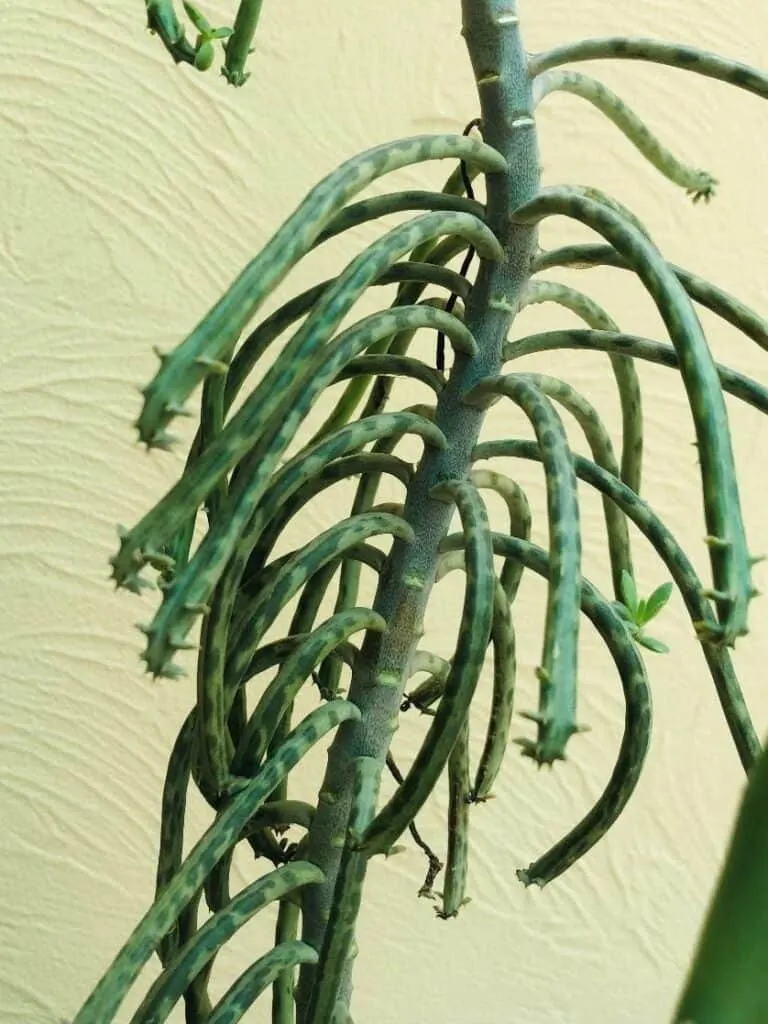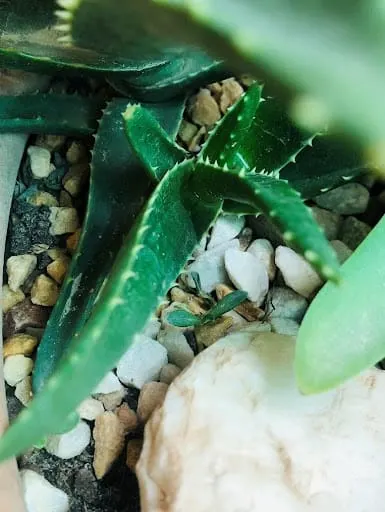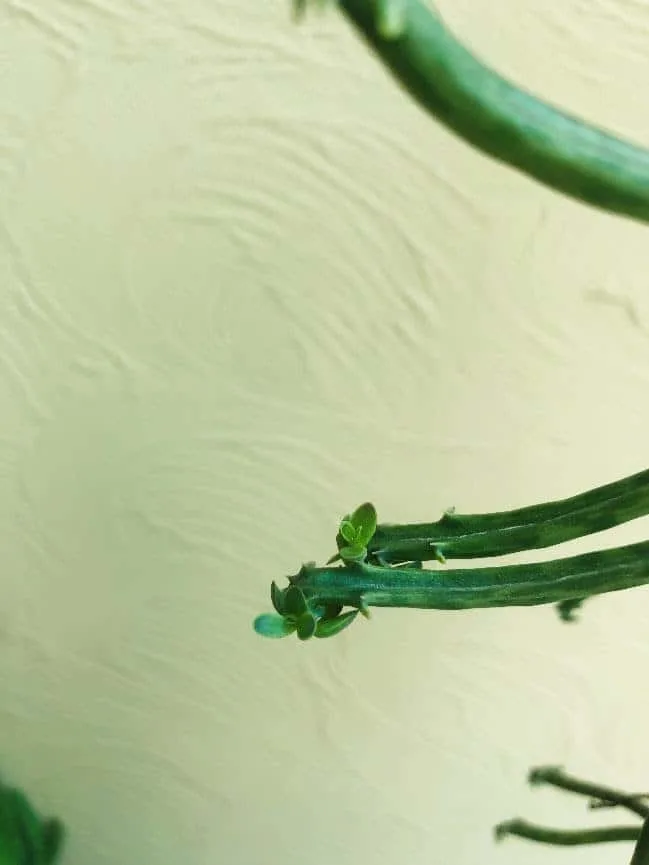The Mother of Millions is an herbaceous succulent plant native to Africa, specifically to the island of Madagascar. Formerly classified as Bryophyllum delagoense, the peculiar-looking plant is now scientifically known as Kalanchoe delagoensis.
It also goes by the name of the Chandelier plant because of its shape. Or the Lizard plant because of the reptilian marks on its thick succulent leaves.
With its unique shape, color, and foliage marks, the Mother of Millions is one of the most unusual plants you can grow.
Table of Contents
Mother of Millions Plant Care Guide
To grow Mother of Millions as a houseplant, it is recommended to use a well-draining, sandy potting mix. It loves direct sunlight but can be grown indoors with 4-6 hours of bright sunlight every day. Water in moderation only when soil is dry, optimum growing temperatures are 65-95°F (18-35°C).
Soil
The Mother of Millions succulent is able to grow virtually in any kind of soil. The plant is incredibly tolerant of infertile and shallow soil and can establish itself where other plants cannot. To grow as a houseplant, it is recommended to use a well-draining, sandy potting mix.
Mother of Millions plants is considered an invasive species in Africa, Australia, and some U.S. states. It is commonly found as a weed in grazing pastures, open woodlands, grasslands, disturbed sites, waste areas, fence lines, roadsides – virtually anywhere there is penetrable ground.
Not only that, but the succulent plant is also frequently found growing out of rocky sites and even on poor soils that do no support other vegetation. You might find yourself surprised after learning how easily a M.O.M plant can grow in any kind of soil.
Of course, when growing Mother of Millions as a houseplant, you would want to give it the best home to live in. The most straightforward potting mix choice for the Chandelier plant is the usual cactus potting mix.
Because this plant is not finicky about the soil, you can use virtually anything. Even garden dirt, for that matter. But ensure that it drains well by adding a few parts of sand and some organic matter to support healthy growth.
Light
Being a succulent, Mother of Millions loves direct sunlight. They thrive in hot climates where they can enjoy the sun all day round. It can also be grown indoors but only in spots where they can get at least 4-6 hours of bright sunlight.
The dark green foliage of the M.O.M plant indicates it has relatively more chlorophyll to absorb light and fulfill its light requirements. This means that the extra chlorophyll enables the plants to do better in low-light conditions where other light-colored succulents suffer.
Although this is a sign that the plant can be grown well under a tree canopy or indoors, this does not mean you can put it in a darker corner as you can with a Snake Plant. It is advised to let the plant receive direct sunlight.
When growing indoors, place next to a window that receives direct sunlight for a considerable amount of time every day. You must, however, note that in summers, the sunlight intensity can get amplified through a glass window and may cause damage to your succulent.
The tough Chandelier plant also has a way of telling you it needs more light. Typically, the spacing between each leaf level on a M.O.M is a little less than half a centimeter.
When the plant receives less light than it needs, leggy growth starts appearing. The distance between each leaf level increases, leaves grow pale, and the marbling pattern on leaves disappears. These are all the signs your plant needs more light.
Watering
This succulent requires water in moderation and should only be watered once the soil is dry. This succulent will not display any signs of being thirsty even if left unwatered for days. So special care is needed by checking the soil if it needs water.
Mother of Millions thrives in arid and semi-arid conditions and is extremely drought tolerant. It will only require water once or twice per week in the growing season and even less frequently in the winter months.
As mentioned above, Chandelier plants are a tough species. They will stand erect even when no moisture is present in the soil. This gives you a bit of leeway if you miss a watering here and there, but this does not mean the plant will not suffer damage.
Leaves will eventually wilt, and twist down when not watered for days in the summer, especially when potted in small pots.

The best way to check if your Mother of Millions needs water is by picking up the pot and feeling its weight or touching the soil with your finger. If the pot seems light to pick up, it means water is needed.
Over-watering can make this plant suffer more than underwatering. An overwatered plant will display signs of distress such as drooping leaves and premature plantlet dropping.
Temperature
Chandelier plants are naturally found in sub-tropical, tropical, and regions with warmer climates. These plants love high temperatures and thrive in the range of 65-95°F (18-35°C). It is hardy from USDA Hardiness Zones 9b-11.
You can grow a Mother of Millions plant outdoor all year round if you live in zones 9b-11. However, if you live in a colder region, the plant will have to come indoors as it will not survive frost.
The plant will stop growing beneath 50°F (10°C). When brought indoors to overwinter, your Chandelier plant may suffer cold if placed near the window if the outdoor temperatures drop below freezing. Using a grow light to supply heat and light is a good option in such a situation.
Humidity
The Mother of Millions plant doesn’t need high humidity to thrive. They are known to thrive in desert-like conditions with humidity levels lower than 20%. Their growth and reproduction rate increase when humidity rises.
Like most other succulents, the Chandelier plant does well in low to moderate humidity. If you’re using a humidifier for other indoor plants, it is recommended to place your Chandelier plant and other succulents away from the humidifier.
Fertilizer
These drought-tolerant plants are not heavy feeders and do not require frequent fertilization. However, they can quickly grow in size if provided the right nutrients. Fertilize your Mother of Millions every month to support a large and strong plant structure.
These plants typically do well in infertile soil and do not need a lot of soil nutrients to thrive. Still, when growing in a pot, a plant will eventually need fertilization. Especially when growing in a majorly sandy, gritty potting mix.
Mother of Millions plants can quickly grow into remarkably large succulents up to 2 meters in height. However, to support such a tall herbaceous structure, the plant will need adequate calcium and other vital minerals in the soil.
You can feed this plant with mild applications of liquid fertilizer for cacti every month, only during the growing season.
Growth
Mother of Millions plant is a fast-growing species that develops as a single stem plant with leaves growing on its side. The plant can grow as tall as 2 meters, with tubular leaves as long as 2-5 inches.
A Mother of Millions plant can grow from a seedling into a mature plant within a year. The thick, cylindrical herbaceous stem grows upright with thick tube-like leaves attached to it. A few sets of leaves at the bottom of the plant are sterile and do not have plantlets.
The leaves feature a reptile-like marbling pattern that gives the plant the name, Lizard plant. The plant primarily reproduces asexually with tiny plantlets attached to their ends, which can easily germinate when they fall to the ground.

Each plant can give rise to thousands of new baby plants, and they, in turn, result in thousands of M.O.Ms each. Hence, the name, Mother of Millions.
When mature, the succulent blooms in the winter and have orange-red flowers. The flowers appear in clusters atop each Mother of Millions stem.
Potting
The Mother of Millions plant can grow well in pots but will need a large-medium-sized pot to grow to its maximum size. This plant will suffer in pots that don’t have adequate drainage.
It is recommended to use a clay pot. Drainage holes are a must. To improve drainage even more, place pot break pieces or pebbles at the bottom of the pot before you pour in the potting mix.
This ensures the drainage hole remains unclogged and the water does not sit in the soil.
If you live in a hot climate, choosing larger pots is a better option than small ones. Soil moisture tends to evaporate from small pots pretty quickly, leaving your plant thirsty in hot summer months.
Even a Mother of Millions succulent stands chances of wilting in small pots when not watered regularly.
On the other hand, large pots can retain soil moisture for much longer, and the plant can still access the moisture it needs that is kept safe deep inside larger pots.
Pruning
A Mother of Millions can grow pretty tall, pretty fast, and it may make caring for it harder for you if you’re growing it as a houseplant. If it seems too tall, you can simply cut the top of the plant off, and it will grow new, denser leaves from the bottom of the stem.
When it comes to succulents, pruning really isn’t a necessity. These plants usually don’t grow too far and wide to need pruning. But the M.O.M is an exceptional case.
Chandelier plants can grow tall in a leggy, wiry manner and may not look good if left to grow unchecked. The plant does have a self-pruning mechanism where the top part simply breaks off and falls to the ground after the plant gets too tall to support itself.
If you don’t have that long to wait, simply chop the plant off to size. New, better-looking growth will follow if it’s the growing season.
Mother of Millions Propagation
The Mother of Millions plant can be easily propagated from plantlets available at the end of each leaf, from leaf and stem cuttings, and also from seed. Just scatter the plantlets on moist ground, and all of them will develop into new plants very soon.
Frankly put, if there’s one plant no one will ever need to make an effort to propagate, it is the Mother of Millions.
This plant self-propagates from the tiny plantlets on its leaves, and you will very often find tiny M.O.Ms sprouting out of every pot in your house.

With a weedy touch to it, removing M.O.M plantlets from places they are not wanted is a job you’ll always be doing as long as there is a M.O.M plant in your home.
Better yet, use all those plantlets and put them somewhere you want them to grow, and Voila!
Common Problems with Mother of Millions
Although the Mother of Millions plant is not susceptible to many pests and diseases, this ornamental succulent may become a problem itself if not taken care of properly.
This plant is categorized as a category 3 invasive plant according to the Biosecurity Act of 2014. A M.O.M plant must not be released into the environment, where it may spread exponentially.
Moreover, this plant is toxic if ingested and has resulted in a considerable number of animal deaths in the past. Before you bring the plant home, it is a good idea to review the decision with all these factors in mind.
Conclusion
Mother of Millions or the Chandelier plant is a rare species that can add a unique touch to your plant collection.
Its unusual shape and foliage look really good when planted in clusters.
If you decide to get this plant, make certain that you are ready to care for it. Well, it doesn’t require much care itself but just so that it does not become a self-invited weed for you.
Frequently asked questions about the Mother of Millions plant
Is a Mother of Millions plant harmful for other plants?
The Mother of Millions plant is an invasive species but not a parasitic one. They will not harm any other vegetation unless they are multiplying rapidly and crowding out other plants in the natural landscape.
Is a Mother of Millions plant toxic to humans?
This plant will not cause irritation if touched but is highly toxic if ingested. The poisonous elements present in the plant can lead to heart failure. They are present in all parts of the plant but are five times more concentrated in the flowers.

Daniel has been a plant enthusiast for over 20 years. He owns hundreds of houseplants and prepares for the chili growing seasons yearly with great anticipation. His favorite plants are plant species in the Araceae family, such as Monstera, Philodendron, and Anthurium. He also loves gardening and is growing hot peppers, tomatoes, and many more vegetables.


